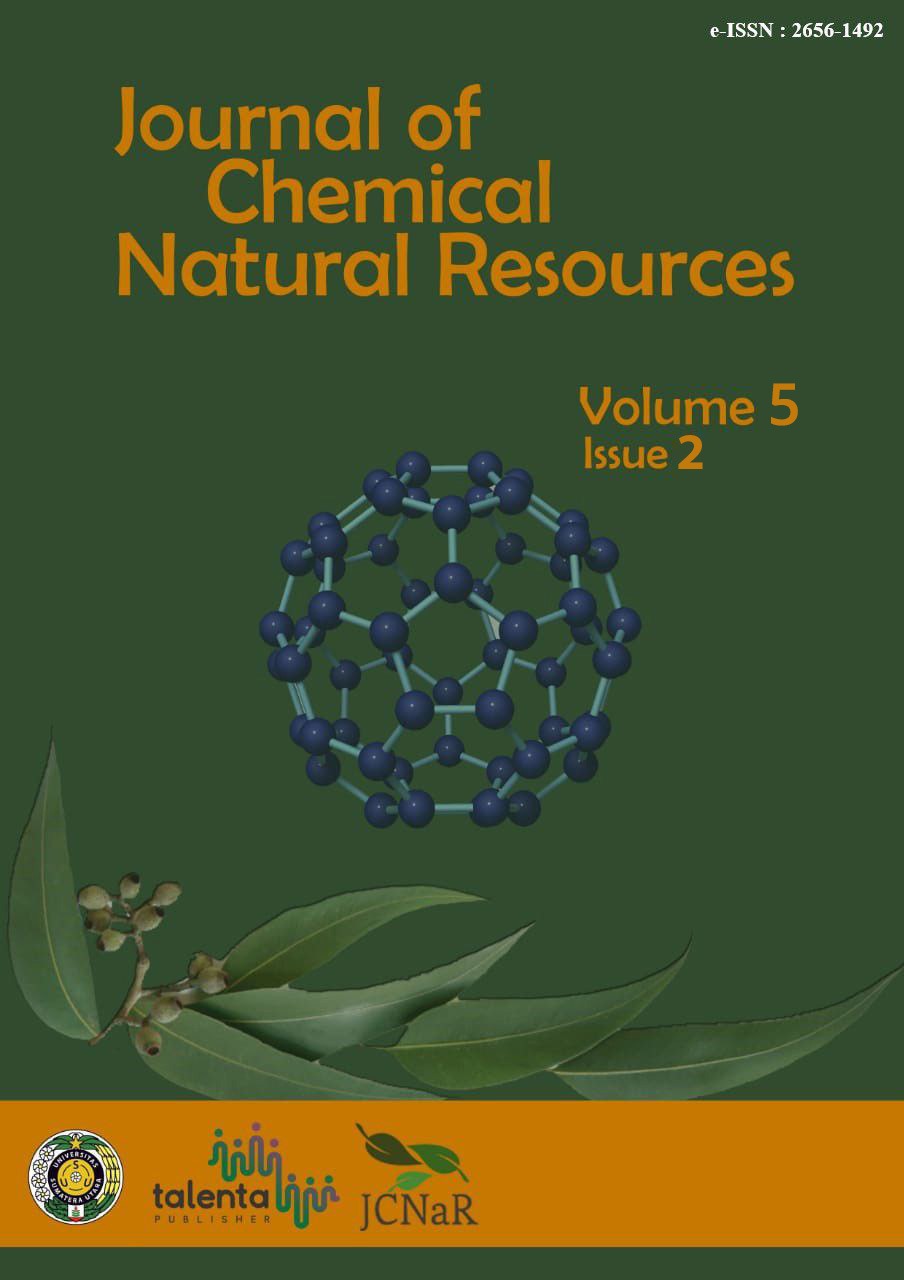Isolation of Sillica from Pantai Cermin Sand and Modification with Sodium Lauryl Sulfate and Ligan Ethylendyamine Through Coating Method as Absorption of Pb Metal
DOI:
https://doi.org/10.32734/jcnar.v5i2.13785Keywords:
Adsorbent, Coating, Ethylenediamine, Sodium Lauryl Sulfate, SilicaAbstract
Research on the formation of synthesis and modification coating of silica and obtained silica with a quartz structure used to absorb lead metal ions. This isolation was performed by extracting silica from sand with the co-precipitation method using NaOH 7M and then adding HCl 2M. The resulting silica was coated with sodium lauryl sulfate and ethylenediamine to increase adsorption. The FT-IR spectrum on silica shows the presence of Si-O-Si, Si-O-, Si-OH, S–O, SO3, CH2, and NH—Sillica coating, which sodium lauryl sulfate and ethylenediamine ligands were carried out by coating method at pH 2. The results obtained before and after coating on silica were characterized by FT-IR, XRD, and SEM EDX analysis. The FT-IR spectrum on sillica showed the presence of Si-O-Si, Si-O, and Si-OH functional groups. After the coating, there was a change in the spectrum, indicating new functional groups in the S-O, SO3, CH2, and NH spectra. Characterization using XRD shows the diffraction peaks were of 2𛳠27,6297°, which indicates the amorph. After coating, the diffraction peaks appeared at an angle of 2𛳠in the area of 19.62 °, 20.47°, 21.04 °, 25.56 °, 26.50 °, and 29.73 ° with a high enough intensity indicating increased crystallinity. The morphology, composition, and size of the silica produced before and after coating were observed by SEM-EDX. Where there is a change in the size before and after a modification, that is 100,788 nm to 85,3773 nm. Silica before and after coating is used as an adsorbent to reduce levels of heavy metal lead (Pb). This analysis showed that the adsorption of Pb²⺠with silica was 4,5162 ppm, while the adsorption of Pb²⺠after coating was 1,1146 ppm.
Downloads
References
M. Alimin and E. . Suriati, “Mineral Content Analysis of Losari Beach Sand Makassar City Using XRF and XRD,†Chem. J., vol. 17, no. 2, 2016.
F. J. Pettijohn, Sand and Sandstone. New York: Springer, 1987.
Fairus, S. Haryono, H. . Sugita, and A. Sudrajat, “Process of Waterglass Preparation from Silica Sand with Sodium Hydroxide Melter,†Indones. J. Chem. Eng., vol. 8, no. 2, 2009.
T. . Rozi and Astuti, “Effect of Calcination Temperature on the Synthesis of Silica Nanoparticles from Purus Beach, Padang City,†J. Phys. Unand, vol. 5, no. 4, p. 3, 2016.
M. A. Fadhlulloh, “Review on Synthesis of SiO2 Nanoparticles,†J. Process Integr., vol. 5, no. 1, 2014.
D. . Jayanti, “Optimization of pH Parameters in Nanosilica Synthesis from Merapi Iron Sand with Permanent Magnet Extraction Using the Co-precipitation Method,†2014.
B. Rio, “Synthesis of SiO2 Nanoparticles Using the Sol-Gel Method and Its Application to Cytotoxic Activity,†J. Nanotechnol., 2011.
P. K. Jal, S. Patel, and B. K. Mishra, “Chemical modification of silica surface by immobilization of functional groups for extractive concentration of metal ions,†Talanta, vol. 62, no. 5, pp. 1005–1028, 2004, doi: 10.1016/j.talanta.2003.10.028.
X. Yang, S. Liao, J. Zeng, and Z. Liang, “A Mesoporous Hollow Silica Sphere (MHSS): Synthesis Through A Facile Emulsion Approach and Application of Support for High-Performance Pd/MHSS Catalyst for Phenol Hydrogenation,†Appl. Surf. Sci., vol. 257, pp. 4472–4477, 2011.
R. . Larsen, M. Polve, and G. Juve, “Granite Pegmatite Quartz from Evjelveland, Trace Element Chemistry and Implications for the Formation of High Purity Quartz,†Norges Geol. Undersogelse Bull., vol. 436, pp. 57–65, 2000.
A. Mirabi, A. Fasamanesh, and S. Shirdel, “Preparation modified SiO2 nanoparticles with diphenylcarbazone for extraction and preconcentration of trace amounts of chromium ions in food, herbal and natural water samples,†Der Chem. Sin., vol. 3, no. 5, pp. 1245–1251, 2012.
R. Hayati and Astuti, “Sintesis Nanopartikel Silika dari Pantai Purus Padang Dengan Metode Kopresipitasi,†J. Fis. Unand, vol. 4, no. 3, pp. 282–287, 2015.
N. Indrasti, A. Ismayana, A. Maddu, and S. Utomo, “Synthesis of Nano-silica from Boiler Ash in the Sugar Cane Industry using the Precipitation Method.,†Int. J. Technol., vol. 11, no. 2, pp. 422–435, 2020.
A. Yanti et al., “Synthesis and Characterization of the Mcm-48 and Modified NH2 : Dan, Sintesis Serta, Karakterisasi MCM- Gugus, Termodifikasi,†no. 1999, pp. 249–253, 2015.
I. Made Agus Mahardiananta, I. Made Aditya Nugraha, P. A. M. Putra, and I. Gede Sura Adnyana, “Magnetic Stirrer with Speed Advisor and Timer Based on Microcontroller,†J. Robot. Control, vol. 3, no. 1, pp. 18–25, 2022, doi: 10.18196/jrc.v3i1.11279.
R. Silverstein, Spectrometric Identification of Organic Compounds. College of Environmental Science & Forestry., 2005.
T. Hufnagel, Structural Characterization of Amorphous Materials Using Xray Scattering. Maryland: Johns Hopkins University, 1991.
F. Stones, Crystalline Silica Quartz and Cristoballite. OSHA Salt Lake Technical Center, 1981.
S. E. Mischler et al., “Differential activation of RAW 264.7 macrophages by size-segregated crystalline silica,†J. Occup. Med. Toxicol., vol. 11, no. 1, pp. 1–14, 2016, doi: 10.1186/s12995-016-0145-2.
Arnelli, R. Fazira, Y. Astuti, and A. Suseno, “Synthesis of Sodium Lauryl Sulfate (SLS) and Hexadecyltrimethylammonium Bromide (HDTMA-Br) Surfactant- Modified Activated Carbon as Adsorbent for Pb2+ and NO3-,†J. Sci. Appl. Chem., vol. 23, no. 11, pp. 396–402, 2020.
S. Rovani, J. J. Santos, P. Corio, and D. A. Fungaro, “An alternative and simple method for the preparation of bare silica nanoparticles using sugarcane waste ash, an abundant and despised residue in the Brazilian industry,†J. Braz. Chem. Soc., vol. 30, no. 7, pp. 1524–1533, 2019, doi: 10.21577/0103-5053.20190049.
A. M. Elgarahy, K. Z. Elwakeel, S. H. Mohammad, and G. A. Elshoubaky, “A critical review of biosorption of dyes, heavy metals and metalloids from wastewater as an efficient and green process,†Clean. Eng. Technol., vol. 4, no. July, p. 100209, 2021, doi: 10.1016/j.clet.2021.100209.

Downloads
Published
Issue
Section
License
Copyright (c) 2023 Journal of Chemical Natural Resources

This work is licensed under a Creative Commons Attribution-ShareAlike 4.0 International License.














